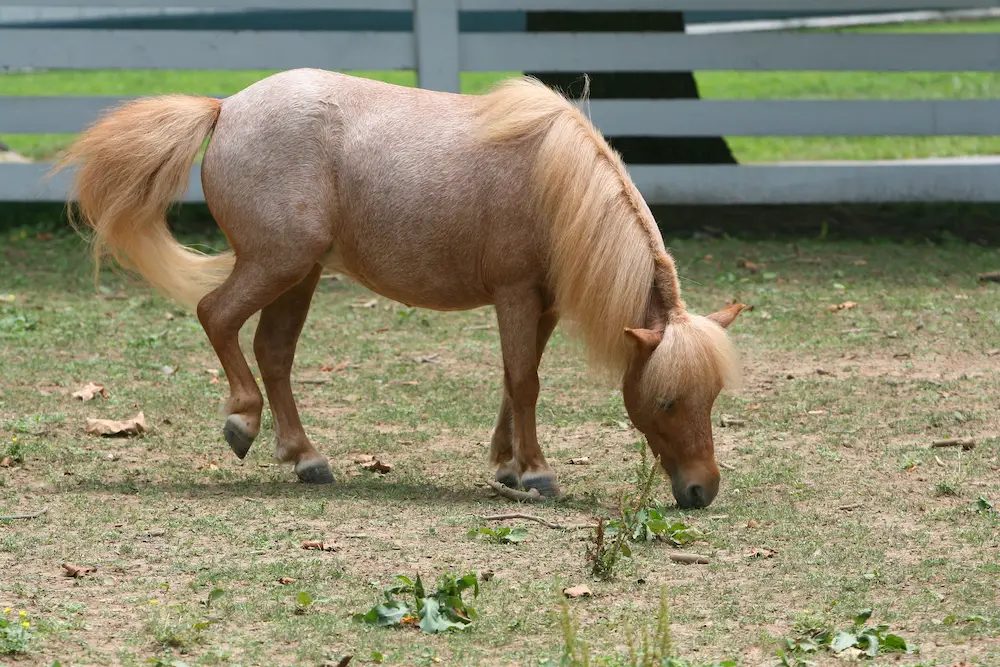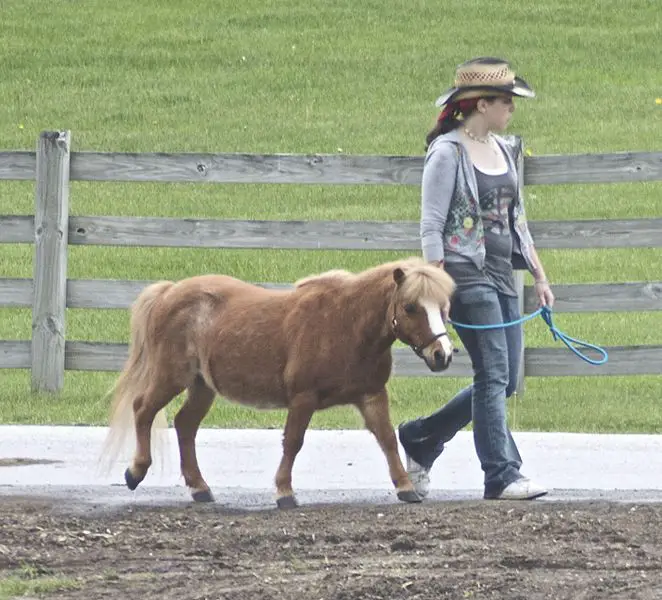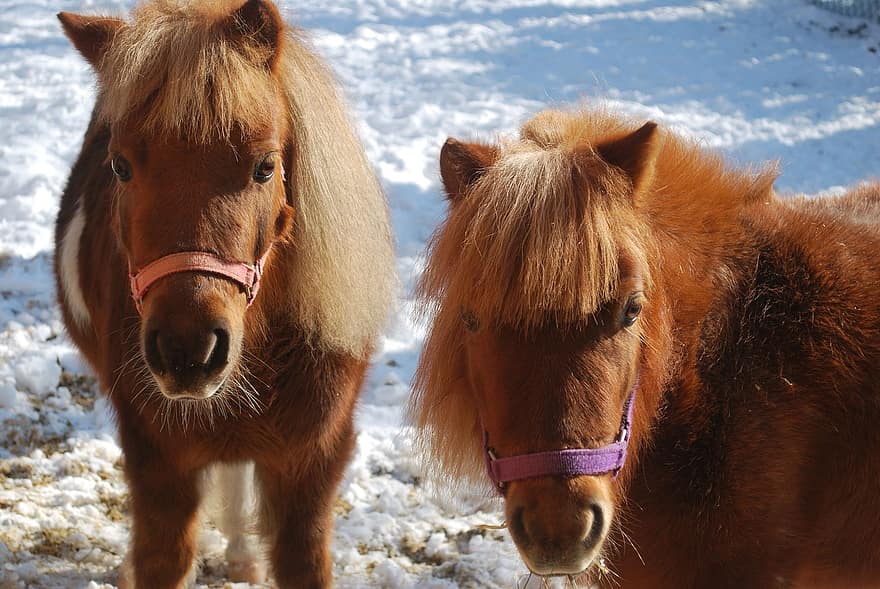Last Updated on August 8, 2020 by Allison Price
What are miniature horses? These are a breed of horse that is usually known to be small in height. Their natural breeds started as larger animals. It grew smaller due to their isolated geographic climates. They can be actually found in many nations, particularly in Europe and the Americas.
The list of mini breeds includes:
- American Miniatures
- Caspian, Falabella
- Netherlands Appy Pony
- Dutch Miniature horse
Two main registries exist for miniature horse:
- The American Miniature Horse Association
- The American Miniature Horse Registry
Also, enthusiasts worldwide formed clubs, registries, and associations. This is to celebrate their shared love of the breed.
Physical Appearance
Miniature horses weigh between 150 to 350 pounds. They grow less than 34–38 inches (86–97 cm) as measured at the last hairs of the mane, which are usually found at the withers. Because of their small heights, they are often mistaken as the same breed of Pony. A miniature horse is not a Pony. Miniature horses are smaller than a pony. They have long, slim legs, the same proportions as a regular-sized horse – just smaller. Pony, on the other hand, is usually known for being a small horse that has a thick neck, stumpy legs, and a thick mane and tail. Miniature horses have various colors and coat patterns. You’ll find solid coats, pintos, and spotted coats like that of the Appaloosa.

Lifespan
They are generally quite hardy. They often live longer on average than some full-sized horse breeds. These miniature horses have 25 to 35 years as their average life span.
Uses
In general, miniature horses are usually bred to be friendly and to socialize with people. They are often kept as family pets, though they still keep their natural horse behavior. That includes natural fighting or flight instinct. Although miniature horses are small, they still need to be still treated like a full grown horse. That is even if they serve as a companion animal. They are also trained as service animals. Just like any service dogs, they are good for people with disabilities. Miniature horses are also qualified for competitions. They can join any horse riding, equine agility, and other competitive shows.
Common Health and Behavior Problems
Most health problems in these horses needed proper nutrition and care. Let us stress the following:
Overfeeding
Overfeeding is a common problem that often leads to obesity of the horse. When owners are then used to owning full-sized horses, they forgot when and how to feed the small ones.
Dental issues
Dental issues include crowding, brachygnathism (overbites), and prognathism (underbites). These are usually seen, due to having the same number of teeth in a much smaller mouth. They also experience retention of deciduous teeth (baby teeth) and sinus problems. These are probable results of overcrowding.
Colic
Colic comes from the combination of a propensity for overeating and dental problems. This can lead to an increased occurrence of colic.
Hyperlipemia
Hyperlipemia is a significant metabolic issue seen most usually in miniature horses. This is where an appetite reducing stressor can cause the body to break down large quantities of fat. Thus, it overwhelms the liver and potentially leading to liver failure.
Reproduction
Reproduction in miniature horses is also more difficult. They have a higher incidence of difficult births and a greater risk for eclampsia.
Proper Care
A miniature horse does need all the same daily care that any horse would need to be healthy and happy. They are actually easy to care for and their daily cost is lower than that of an average horse.

9 Steps to follow to take care of your mini horse:
Step 1: Set up a stall for your miniature horse. A miniature horse needs to be always kept in clean conditions. They need to be also provided with shelter from rain, sun, and wind.
Step 2: Provide access to pasture. It is important to make sure that your horse gets exercise and freedom while roaming around. You should provide approximately at least 1/4 acre per miniature horse.
Step 3: Provide a companion animal. Miniature horses are social creatures and should never be always left alone. You can also use other animals as companion animals, such as donkeys, dogs, sheep, or goats.
Step 4: Give your miniature horse access to grass or feed them hay every day. A miniature horse will eat one to 2% of its body weight in forage every day. Thus, it’s important to provide enough for these animals. If necessary supplement the diet of your miniature horse with grain.
Step 5: Take your horse’s size and body condition into consideration. Miniature horses are prone to becoming overweight. The ideal weight for a miniature horse is anywhere between 150–300 pounds (68–136 kg). Keep an eye on your horse’s size to fine-tune its diet so that it can stay at its ideal weight.
Step 6: Provide access to clean drinking water at all times. It’s important that your miniature horse can drink water whenever it needs. This is so that it stays always hydrated. Be sure that the water is clean and that the container you put the water in is clean as well.
Step 7: Grooming. Miniature horses need the same sort of grooming as bigger horses. There’s just a lot less surface area to cover, which makes the job much easier. Use a comb, brush, and hoof pick on your horse daily to remove any dirt and debris. And try to find a farrier that specializes in miniature horses to maintain your horse’s hooves.
Step 8: Give your horse extra care during cold weather. While miniature horses are actually quite hardy, they need care in freezing conditions. For example, during cold days they need to be always rugged to maintain a stable body temperature.
Step 9: Get them annual veterinary care. Your miniature horse needs regular veterinary care. This is to ensure that it is healthy and does not have any emerging health problems that need treatment.
Miniature Horse as Companions
Miniature horses are best for children aged less than 10 years old. Miniature horses tend to be smart, curious, gentle, and social in nature. They love to spend time with humans. Their friendly nature makes them perfect as family pets. It is ideal to let them live outdoors with shelters like other horses for their health and well-being. Several miniature horses are usually used by blind people as support animals. Not every mini horse is then suited for this job. They need to be in good health and focused on their duties. This is even when faced with distractions and frightening situations in public areas. Like all service animals, a mini horse can help their handlers on the streets. That includes supermarkets, restaurants, and hotels.
How Much Does Miniature Horses Cost?
Because of popularity, miniature horse rescues and breeders are easy to find. Miniature horses cost roughly around $1,000, though you can often find horses to adopt for less. Miniature horses used for breeding can cost more compared to those that are just as pets.


